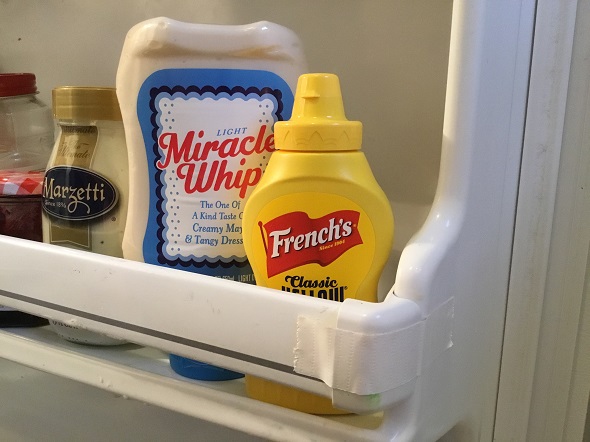When the rung on the bottom shelf of my refrigerator broke, I bought a roll of white duct tape and, as carefully as I could, cut short lengths of duct tape to hold it back in place. I will not win a repair design contest. It’s not “good as new.” The shelf can no longer hold heavy items. But I treasure sandwiches for lunch. Plastic jars of yellow mustard and light mayo reside there reliably. Good enough will do.
Similarly, if I need to abstain from problematic substances, if I can figure out what purposes substances served for me – what needs and wants they filled for me – I might be able to find replacements for them. Since addiction is a brain condition requiring medical care, this effort is unlikely to have a direct, immediate effect on my brain’s functioning. Figuring out the needs and wants that substances assisted me with may not cover the full scope of, or explanation for, my initial or repeated substance use prior to developing addiction. But understanding what substances did for me may help me with my self-care efforts.
Since substances can magnify experience beyond what the brain naturally experiences, I’m unlikely to find identical, snap-in substitutes. Given the interrelated neurocircuitry of love and addiction, this reality creates a deep loss to grieve. While no analogy is perfect, the idea of finding good-enough, duct tape-like replacements might be helpful.
What did substances do for me? Answering that question feels overwhelming! But analyzing my last return to use may help get me started. Let’s break it down.
First, here’s the usual information to gather when seeking self-understanding:
What was I giving my attention to, what was I feeling, what was I thinking, and what physical sensations did I experience?
Many people cannot remember what they were feeling and thinking just prior to use, so that data is usually missing.
Let’s try different time frames – 24 hours, 1 week, 1 month.
Answering these questions might be useful:
1. ATTENTION: What was getting – perhaps splitting – my attention prior to my last return to use? 24 hours before? 1 week before? 1 month before?
2. FEELINGS: What was I feeling prior to my last return to use? 24 hours before? 1 week before? 1 month before?
3. THOUGHTS: What was I thinking prior to my last return to use? 24 hours before? 1 week before? 1 month before?
4. PHYSICAL SENSATIONS: What physical sensations was I experiencing prior to my last return to use? 24 hours before? 1 week before? 1 month before?
5. AWARENESS OF NEEDS AND WANTS THEN: Having become aware of 1) what I was giving my attention to, 2) what I was feeling, 3) what I was thinking, and 4) what physical sensations I was experiencing, what needs and wants did I seem to have prior to my last return to use? 24 hours before? 1 week before? 1 month before?
6. SELF-KINDNESS AND SELF-CARE: AWARENESS OF NEEDS AND WANTS NOW: What needs and wants do I have now? What might I do to kindly and supportively help myself meet these needs and fulfill these wants?
7. What insights have I had as a result of doing this exercise?
8. In what ways can I continue to customize and individualize my treatment plan to help get my needs and wants met? Some good-enough, duct tape-like replacements, perhaps, may decrease the likelihood of my return to use.
The idea is this: If I can become aware, in the moment, that I have unmet needs and wants, strong feelings, intense thoughts, or physical sensations similar to those I experienced prior to past returns to use, I might be able to help myself with them without substances.
. . . . .
Here is a version of this post in the form of a printable handout. (.pdf opens in a new tab.)
If different substances served different needs, printing out multiple copies of the handout and answering the questions for one substance at a time might be helpful.
Last revised 12/7/17
This post is part of a series on evidence-informed self-care for addiction. Self-care is NOT an evidence-based treatment for addiction. The introduction and table of contents are here and posts are published in the category entitled Guide.
The views expressed are mine alone and do not necessarily reflect the positions of my employers, co-workers, clients, family members or friends. This content is for informational purposes only and is not a substitute for medical or professional advice. Consult a qualified health care professional for personalized medical and professional advice.


